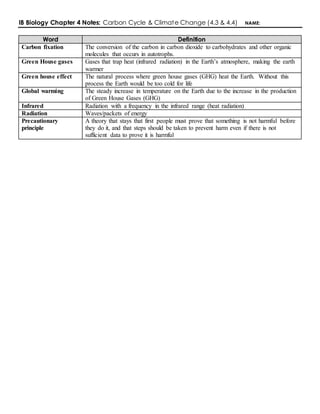
4.3 & 4.4 Notes
- 1. IB Biology Chapter 4 Notes: Carbon Cycle & Climate Change (4.3 & 4.4) NAME: Word Definition Carbon fixation The conversion of the carbon in carbon dioxide to carbohydrates and other organic molecules that occurs in autotrophs. Green House gases Gases that trap heat (infrared radiation) in the Earth’s atmosphere, making the earth warmer Green house effect The natural process where green house gases (GHG) heat the Earth. Without this process the Earth would be too cold for life Global warming The steady increase in temperature on the Earth due to the increase in the production of Green House Gases (GHG) Infrared Radiation with a frequency in the infrared range (heat radiation) Radiation Waves/packets of energy Precautionary principle A theory that stays that first people must prove that something is not harmful before they do it, and that steps should be taken to prevent harm even if there is not sufficient data to prove it is harmful
- 2. 4.3.1 Autotrophs convert carbon dioxide into carbohydrates and other carbon compounds. 4.3.2 In aquatic habitats carbon dioxide is present as a dissolved gas and hydrogen carbonate ions. 4.3.3 Carbon dioxide diffuses from the atmosphere or water into autotrophs. 4.3.4 Carbon dioxide is produced by respiration and diffuses out of organisms into water or the atmosphere. 4.3.5 Methane is produced from organic matter in anaerobic conditions by methanogenic archaeans and some diffuses into the atmosphere. 4.3.6 Methane is oxidized to carbon dioxide and water in the atmosphere. 4.3.7 Peat forms when organic matter is not fully decomposed because of anaerobic conditions in waterlogged soils. 4.3.8 Partially decomposed organic matter from past geological eras was converted into oil and gas in porous rocks or into coal. 4.3.9 Carbon dioxide is produced by the combustion of biomass and fossilized organic matter. Describe what is meant by carbon ‘fixation’ What is methanogenesis? Outline the types of anaerobic organisms that produce methane: Describe what peat is and how it forms: Describe the formation of coal: Describe the formation of oil and natural gas: What occurs in combustion? Give examples of natural and human-caused combustion of organic matter:
- 3. 4.3.10 Animals such as reef-building corals and mollusks have hard parts that are composed of calcium carbonate and can become fossilized in limestone. 4.3.13 Construct a diagram of the carbon cycle. 4.3.11 Estimate carbon fluxes due to processes in the carbon cycle. 4.3.12 Analysis of data from atmosphere monitoring stations showing annual fluctuations. 4.4.1 Carbon dioxide and water vapor are the most significant greenhouse gases. 4.4.2 Other gases,including methane and nitrogen oxides have less impact as greenhouse gases. Describe the formation of limestone: Draw a diagram: Complete the table of carbon flux estimates: Process Flux (Gigatons/ year) Photosynthesis Cell respiration Ocean uptake Ocean loss Deforestation Burial in marine sediment Combustion of fossil fuels Describe how scientists monitor/ track atmospheric carbon dioxide: What is a greenhouse gas? What are sources of atmospheric carbon dioxide and water vapor?
- 4. 4.4.3 The impact of a gas depends on its ability to absorb long-wave radiation as well as on its concentration in the atmosphere. 4.4.4 The warmed Earth emits longer-wave radiation (heat). 4.4.5 Longer-wave radiation is reabsorbed by greenhouse gases which retains the heat in the atmosphere. 4.4.9 Correlations between global temperatures and carbon dioxide concentrations on Earth. 4.4.6 Global temperatures and climate patterns are influenced by concentrations of greenhouse gases. 4.4.7 There is a correlation between rising atmospheric concentrations of carbon dioxide since the start of the industrial revolution two hundred years ago and average global temperatures. 4.4.8 Recent increases in atmospheric carbon dioxide are largely due to increases in the combustion of fossilized organic matter. 4.4.10 Evaluate claims that human activities are not causing climate change. 4.4.11 Threats to coral reefs from increasing concentrations of dissolved carbon dioxide. Outline the two factors that determine the impact of a greenhouse gas: Describe how the Earth’s surface absorbs and emits solar radiation: Describe the greenhouse effect: Outline the climate effects of higher greenhouse gas concentrations and global temperatures: Describe the correlation between atmospheric carbon dioxide and temperature: How is this related to the start of the industrial revolution? Discuss claims that human activities are not related to climate change: How does increasing carbon dioxide threaten coral reefs?
